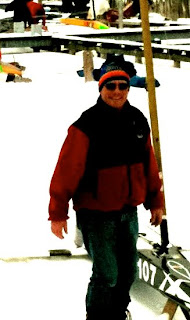

Driving south to sail
Friday, February 5, 2010
The majority of regatta participants is enroute or has arrived. I am driving with two Polish friends, Adam Baranowski and Derek Kardas. Adam met me at Warsaw airport yesterday and we stayed at his house last night preparing boats and equipment. Darek prepared a hull and plank for me. I intend to sail a Sherry mast from Pete’s cache of stuff stored in Olsztyn. I brought key runners but added a few from Pete’s cache. I brought sails. These are wonderful hosts, and we could not escape a short visit with the Marcurs last night without tea and delicious cake with his family.
The boat I am to sail was assembled for the first time at 10 pm yesterday. Such simple boats with so few details you’d think everything would be smooth. But everyone has optimized details, and they all fit together if all is like the other boats and equipment. But there are differences between “normal” in Europe and in North America. Some of the differences require on-the-spot correction, better done in a shop than on the ice.
Runner “normal” in Europe fit chocks that are 26mm, just a bit more than NA normal of one inch, 25.4mm. Chock bolts are 10 mm, just a bit more than 3/8 inch. Some are 12 mm, which is what Bob Cummins is using, which is quite a bit more than 3/8 inch. This means US runners need to be drilled so the chock bolt will fit.
On the boom, the outhaul systems on US fit outside the sail track, either above or below it. Here the normal is to fit 1-D sails who have a different detail, slider car and cut-back bolt rope. When fitting the Polish normal outhaul system onto North/Boston or Quantum sails, the hardware has to be adapted to fit around a full length bolt rope. Or the sail has to adjusted by cutting away a bit of bolt rope under the clew.
And the hull fastens to the plank differently. Only a problem if fitting a European hull to a US plank. Plus normal preparation of runners, sorting and packing bags and boxes, tools and spares, ice clothes and other clothes.
We also had to finish the new hull. Foot braces, hull numbers, bobstay strut, rough-fit of wires, adjust halyard catch locations. All stuff done once over a few weekends of sailing normally, but done here prior to the auto-portion of the trip. Personally, a 10 pm departure, 9 hour flight, three hour drive and prep to midnight mad for a slightly long day. On the bright side, I am now time-zone adjusted.
This morning we made final runner fit and packed trailer and car for three competitors. No matter what breaks, we will finish the two planned regattas with enough equipment. This is a crazy sport! We have in/on the trailer and mini-van the following:
- five hulls
- 8 masts
- 8 sails
- We think we have 92 runners, more or less
- A generator
- Two “drill machines” (hand drills)
- A runner sharpening machine
- Spare tire for trailer
- Spare lights and fuses (needed one 25 miles out)
- Spare hardware and wires
We heard that Stan Macur, who left last night, needs a spare transmission. Unfortunately, we cannot help him.
Finally packed and ready, we hit the road about 11:30 this morning for the 1000 km trip. Did I mention that Poland has no freeways? ETA between 10 and midnight tonight, Poland-Czek Republic-Slovakia-Hungary.
The US team consists of Wendell Sherry, Bob Cummins, Mike Derusha and I from the Western Region, Ron Sherry and Aaron Stanger from the Central Region, Dan Connell and Hal Bowman from the Eastern Division. Bob Cummin’s daughter Annie is on the race committee. We have hosts helping from several countries, but I want to get that right before posting.
Morning update. February 6, 2010. We arrived today at 2AM to the hotel Flamingo and a dusting of snow. Today: set up and practice.
































